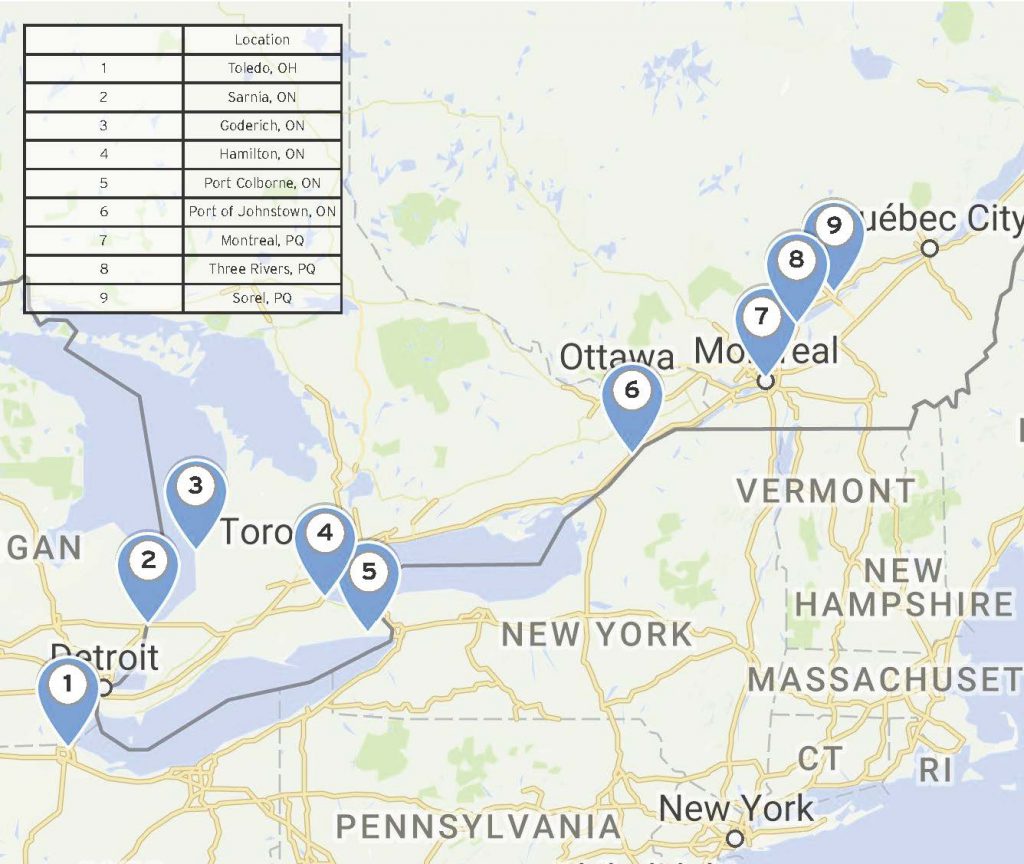Location, location, location
THE COMPETITIVE LAKE ONTARIO EXPORT MARKET

ONE OF THE most encouraging things to watch in the Ontario grain markets through the 2017 harvest period was how strong cash basis levels have remained despite a rather large crop both within Ontario, and also for the broader North American market.
If you compare the basis levels for soybeans being bid in the lake terminals in Toledo, Ohio to the values bid by the Hamilton export terminals through the months of October and November, the Ontario terminals maintained a 20 cent U.S. per bushel premium over their American counterparts right through the fall season.
Throughout October, this fall’s busy season of exporting soybeans at the Hamilton terminals have typically been bidding basis values (converted into U.S. funds) of $-0.10 to $-0.15 under Chicago, while Toledo has typically posted U.S. basis bids of $-0.30 to $-0.35. While 20 cents per bushel doesn’t sound like a big premium, when you consider that Ontario produces nearly 145 million bushels of soybeans, it’s clear that the competitiveness of the Lake Ontario export market pushes an enormous number of dollars back into the hands of this province’s soybean producers.
HIGHER VALUES
There are a couple of reasons why the Hamilton soybean market bids higher values than terminals further inland in the Great Lakes shipping lanes.
The first of these is simply a matter of geography. Lake Ontario is simply closer to the Atlantic Ocean, and vessels can’t sail across Lake Erie or through the Welland Canal for free. There are both more empty ships that become available nearer the mouth of the St. Lawrence Seaway than there are further inland, and the journey to the ultimate destination is shorter for ships which start further downstream. The freight savings enable exporters to bid more for soybeans which can be loaded in an advantageous origin.
The second reason for the Ontario basis bids to be so much stronger is simply the result of healthy competition. Ontario soybean growers are extremely fortunate to have four export terminal operators, two crush plants, and several food grade soybean processors all competing to originate soybeans from this province. Ontario farmers have a lot of choice about how and where to market their crop, and the fierce competition tugs all of the slack out of the prices being paid.
Access to global markets has also been beneficial for corn prices in Ontario this harvest. With western Ontario corn bids at $+0.10 CZ17, central Ontario at $+0.15 CZ17, and eastern Ontario at $+0.30 CZ17 (all in U.S. funds), our province’s corn market is markedly stronger than the $-0.10 CZ17 posted in Toledo. In fact, the current basis levels being bid for corn in the eastern Ontario market are within a nickel of the values posted for New Orleans where U.S. heartland corn is barged in to load ocean vessels for export around the world.
The greatest potential risk to the Ontario grain markets being able to maintain their premium basis levels relative to the surrounding American grain buyers is that if the price gap between Ontario and nearby U.S. states becomes too wide, it leaves the door open to American corn and soybeans flowing into our domestic processors. It’s certainly not hard for soybeans and corn from Michigan to travel into Canadian grain processors in Sarnia, Windsor, and London. At which point, Ontario’s premium priced grain market would simply be overwhelmed by the potential supply of U.S. inflows.
Ontario’s geographical advantage in terms of marine access to international markets has a certain seasonality to it. We don’t use railroads or trucks to ship grain to Europe or Carribean destinations. It’s entirely dependent on the Great Lakes — St Lawrence seaway shipping lanes. Obviously winter ice causes the marine shipping channel to be ineffective for the first three months of the year, so we typically see our biggest stretches above U.S. replacement commodity prices in the fall and spring when the bidding in the export markets is the most enthusiastic.

The teeter-totter that Ontario grain producers need to monitor and manage as they plan out their marketing strategy for grains and oilseeds is to watch for the opportunities which recognize our natural geographic advantage in terms of easy access to the world market, while observing the price gap between our end users and lower priced U.S. origins which could slide in and backfill our demand from behind. An important number to always have in mind is the U.S. replacement cost, which is what it would take to bring replacement corn or soybeans into your sales market, and then have the discipline to make sales in the time windows when export demand stretches our values out to our regions full locational advantage.
Stephen Kell is the business manager — branch grain for Parrish & Heimbecker. He has 25 years of experience in the Ontario grain industry. •





















